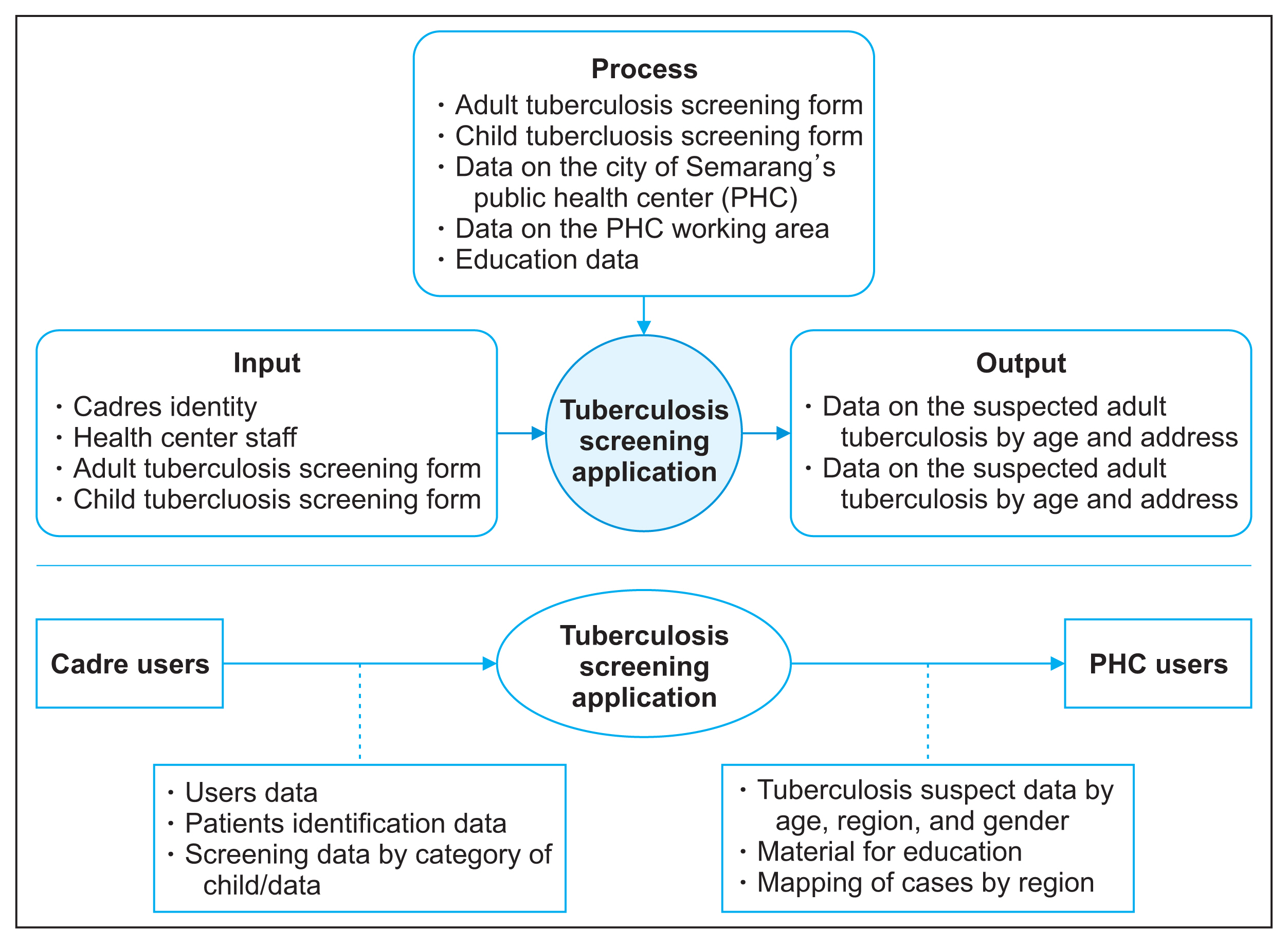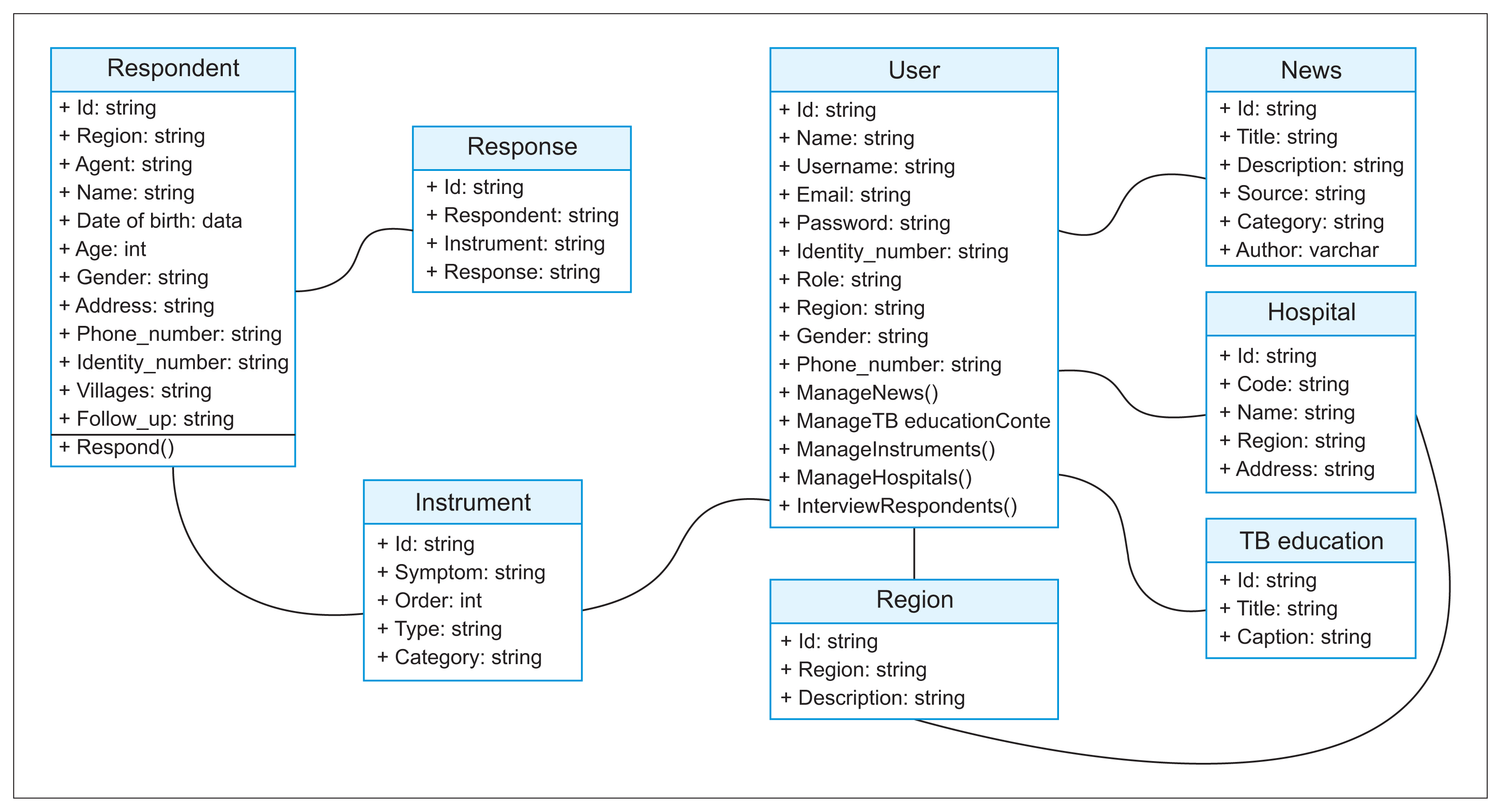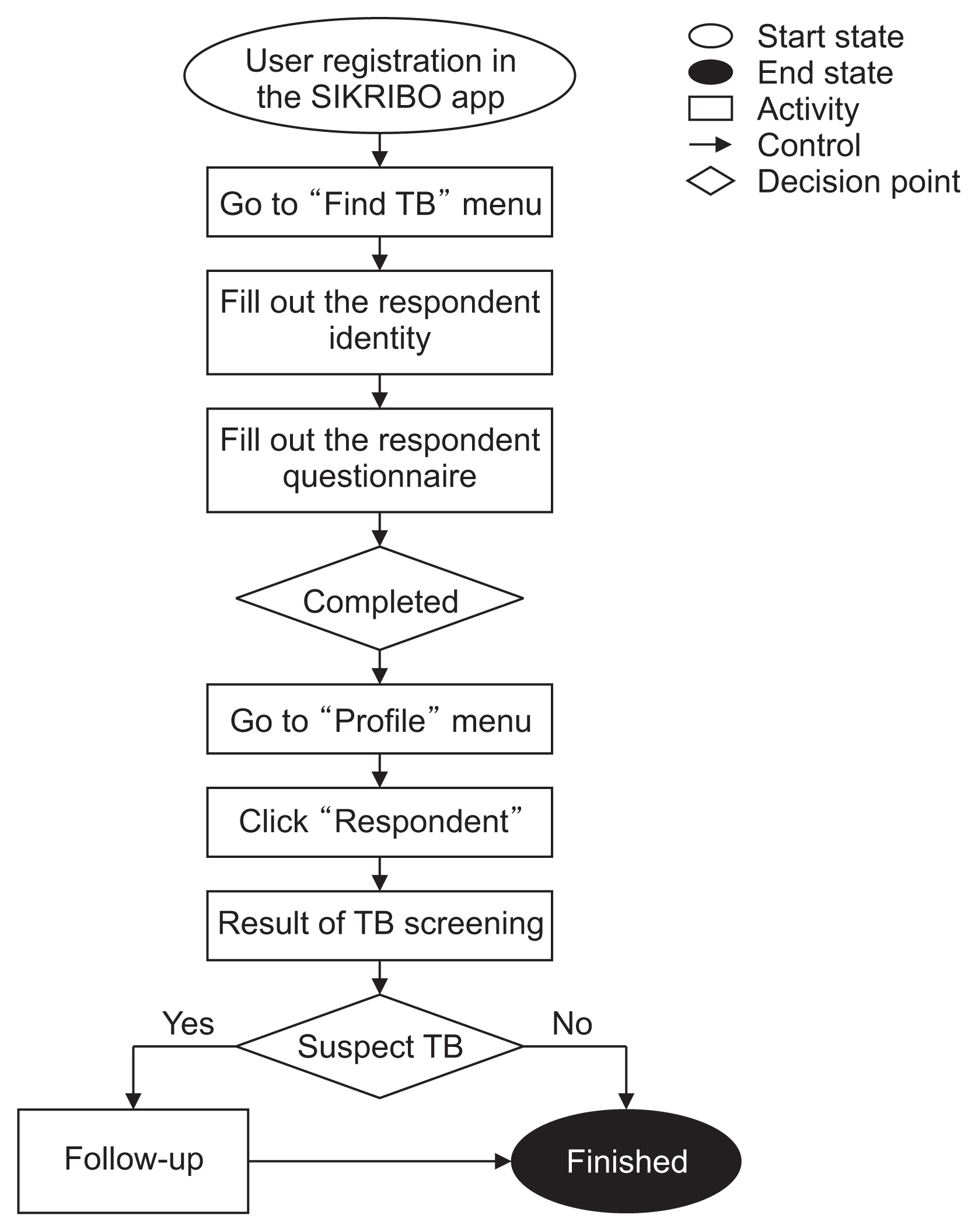Healthc Inform Res.
2022 Oct;28(4):297-306. 10.4258/hir.2022.28.4.297.
Development of the SIKRIBO Mobile Health Application for Active Tuberculosis Case Detection in Semarang, Indonesia
- Affiliations
-
- 1Master of Public Health Study Program, Universitas Negeri Semarang, Semarang, Indonesia
- 2Department of Public Health, Universitas Negeri Semarang, Semarang, Indonesia
- 3Semarang City Health Office, Semarang, Indonesia
- 4Integrated Service Unit of Information and Communication Technology, Universitas Negeri Semarang, Semarang, Indonesia
- KMID: 2535805
- DOI: http://doi.org/10.4258/hir.2022.28.4.297
Abstract
Objectives
This study was conducted to document the development and usability testing of SIKRIBO, a tuberculosis screening application.
Methods
The SIKRIBO application was developed using design science research methodology, which has six steps: problem identification and motivation, definition of objectives for a solution, product design and development, demonstration, evaluation, and communication. A system usability scale (SUS) questionnaire was used to assess application usability. A total of 20 health cadres (trained community members) and health workers participated in the usability tests.
Results
Two versions of the application were developed: Android-based for users and web-based for administrators. The Android-based version has four main menus: Find Tuberculosis, Tuberculosis Education, Latest Info, and Profile. The web version is accessible to health workers, as well as the research team and application developers who monitor and manage the user-conducted screenings. The average SUS score was 76 (standard deviation, 8.00).
Conclusions
This application was developed to help detect active tuberculosis cases in the community. The SUS results indicate that the application is highly usable. Thus, SIKRIBO is expected to be broadly implemented to increase tuberculosis case detection through active community participation.
Figure
Reference
-
References
1. World Health Organization. Global tuberculosis report 2020. Geneva, Switzerland: World Health Organization;2020.2. Kristini T, Hamidah R. Potential for pulmonary tuberculosis transmission to patients family. Indones J Public Health. 2020; 15(1):24.3. Abayneh M, HaileMariam S, Asres A. Low tuberculosis (TB) case detection: a health facility-based study of possible obstacles in kaffa zone, southwest district of ethiopia. Can J Infect Dis Med Microbiol. 2020; 2020:7029458. https://doi.org/10.1155/2020/7029458 .4. Rahayu SR, Katsuyama H, Demura M, Katsuyama M, Ota Y, Tanii H, et al. Factors associated with tuberculosis cases in semarang district, Indonesia: case-control study performed in the area where case detection rate was extremely low. Environ Health Prev Med. 2015; 20(4):253–61. https://doi.org/10.1007/s12199-015-0443-9 .5. Huddart S, Bossuroy T, Pons V, Baral S, Pai M, Delavallade C. Knowledge about tuberculosis and infection prevention behavior: a nine city longitudinal study from India. PLoS One. 2018; 13(10):e0206245. https://doi.org/10.1371/journal.pone.0206245 .6. Indonesian Health Ministry. Indonesia health profile 2020. Jakarta, Indonesia: Indonesian Health Ministry;2021.7. Semarang City Health Office. Situation analysis of tuberculosis eradication program in 2021. Semarang, Indonesia: Semarang City Health Office;2021.8. Chiang CY, Islam T, Xu C, Chinnayah T, Garfin AM, Rahevar K, et al. The impact of COVID-19 and the restoration of tuberculosis services in the western pacific region. Eur Respir J. 2020; 56(4):2003054. https://doi.org/10.1183/13993003.03054-2020 .9. Iribarren SJ, Schnall R, Stone PW, Carballo-Dieguez A. Smartphone applications to support tuberculosis prevention and treatment: review and evaluation. JMIR Mhealth Uhealth. 2016; 4(2):e25. https://doi.org/10.2196/mhealth.5022 .10. Sadiku MN, Shadare AE, Musa SM. Mobile health. Int J Eng Res. 2017; 6(10):450–2. http://dx.doi.org/10.5958/2319-6890.2017.00061.7 .11. Osei E, Agyei K, Tlou B, Mashamba-Thompson TP. Availability and use of mobile health technology for disease diagnosis and treatment support by health workers in the Ashanti region of Ghana: a cross-sectional survey. Diagnostics (Basel). 2021; 11(7):1233. https://doi.org/10.3390/diagnostics11071233 .12. Newzoo. Newzoo global mobile market report 2021 [Internet]. San Francisco (CA): Newzoo;2021. [cited at 2022 Oct 10]. Available from: https://newzoo.com/insights/trend-reports/newzoo-global-mobile-market-report-2021-free-version/ .13. Keutzer L, Wicha SG, Simonsson US. Mobile health apps for improvement of tuberculosis treatment: descriptive review. JMIR Mhealth Uhealth. 2020; 8(4):e17246. https://doi.org/10.2196/17246 .14. Lapao LV, da Silva MM, Gregorio J. Implementing an online pharmaceutical service using design science research. BMC Med Inform Decis Mak. 2017; 17(1):31. https://doi.org/10.1186/s12911-017-0428-2 .15. Nalendra AK. Rapid application development (RAD) model method for creating an agricultural irrigation system based on internet of things. IOP Conf Ser Mater Sci Eng. 2021; 1098:022103. https://doi.org/10.1088/1757-899X/1098/2/022103 .16. Sharfina Z, Santoso HB. An Indonesian adaptation of the system usability scale (SUS). In : Proceedings of 2016 International Conference on Advanced Computer Science and Information Systems (ICACSIS); 2016 Oct 15 16; Malang, Indonesia. p. 145–8. https://doi.org/10.1109/ICACSIS.2016.7872776 .17. Nielsen J. Quantitative studies: how many users to test? [Internet]. Fremont (CA): Nielsen Norman Group;2006. [cited at 2022 Oct 24]. Available from: https://www.nngroup.com/articles/quantitative-studies-how-many-users/ .18. Benmoussa K, Laaziri M, Khoulji S, Kerkeb ML, El Yamami A. Evaluating the usability of a Moroccan University research management web platform. Procedia Manuf. 2019; 32:1008–16. https://doi.org/10.1016/j.promfg.2019.02.315 .19. Akmal Muhamat N, Hasan R, Saddki N, Mohd Arshad MR, Ahmad M. Development and usability testing of mobile application on diet and oral health. PLoS One. 2021; 16(9):e0257035. https://doi.org/10.1371/journal.pone.0257035 .20. Zhou L, Bao J, Setiawan IM, Saptono A, Parmanto B. The mHealth app usability questionnaire (MAUQ): development and validation study. JMIR Mhealth Uhealth. 2019; 7(4):e11500. https://doi.org/10.2196/11500 .21. WHO guidelines on tuberculosis infection prevention and control: 2019 update. Geneva, Switzerland: World Health Organization;2019.22. Amagai S, Pila S, Kaat AJ, Nowinski CJ, Gershon RC. Challenges in participant engagement and retention using mobile health apps: literature review. J Med Internet Res. 2022; 24(4):e35120. https://doi.org/10.2196/35120 .23. Pande T, Saravu K, Temesgen Z, Seyoum A, Rai S, Rao R, et al. Evaluating clinicians’ user experience and acceptability of LearnTB, a smartphone application for tuberculosis in India. Mhealth. 2017; 3:30. https://doi.org/10.21037/mhealth.2017.07.01 .24. Liew MS, Zhang J, See J, Ong YL. Usability challenges for health and wellness mobile apps: mixed-methods study among mhealth experts and consumers. JMIR Mhealth Uhealth. 2019; 7(1):e12160. https://doi.org/10.2196/12160 .25. Idrus L, Fitria N, Hasan N, Postma M, Alffenaar JW. The usability testing of the integrated e-healthcare services (IEHS) web-based application in the therapy management of HIV and tuberculosis in Indonesia. Value Health Reg Issues. 2020; 22:S57. https://doi.org/10.1016/j.vhri.2020.07.300 .26. Georgsson M, Staggers N. Quantifying usability: an evaluation of a diabetes mHealth system on effectiveness, efficiency, and satisfaction metrics with associated user characteristics. J Am Med Inform Assoc. 2016; 23(1):5–11. https://doi.org/10.1093/jamia/ocv099 .27. Osei E, Mashamba-Thompson TP. Mobile health applications for disease screening and treatment support in low-and middle-income countries: a narrative review. Heliyon. 2021; 7(3):e06639. https://doi.org/10.1016/j.heliyon.2021.e06639 .28. Faujdar DS, Singh T, Kaur M, Sahay S, Kumar R. Stakeholders’ perceptions of the implementation of a patient-centric digital health application for primary healthcare in India. Healthc Inform Res. 2021; 27(4):315–24. https://doi.org/10.4258/hir.2021.27.4.315 .29. Mahmood A, Kedia S, Wyant DK, Ahn S, Bhuyan SS. Use of mobile health applications for health-promoting behavior among individuals with chronic medical conditions. Digit Health. 2019; 5:2055207619882181. https://doi.org/10.1177/2055207619882181 .
Article
- Full Text Links
- Actions
-
Cited
- CITED
-
- Close
- Share
- Similar articles
-
- Evaluation of the Usability and User Experience of the Jaminan Kesehatan Nasional Mobile Application in Indonesia
- Impact of Dengue Surveillance Workers on Community Participation and Satisfaction of Dengue Virus Control Measures in Semarang Municipality, Indonesia: A Policy Breakthrough in Public Health Action
- Mental Health Condition of Adolescents to Early Adulthood: A Study of Indonesian College Students
- Identification of a Novel CHD7 Mutation in a CHARGE Syndrome Patient in Indonesia
- Influence of internet, mobile phone use, and sociodemographic factors on women’s knowledge and attitude towards contraception in Indonesia









